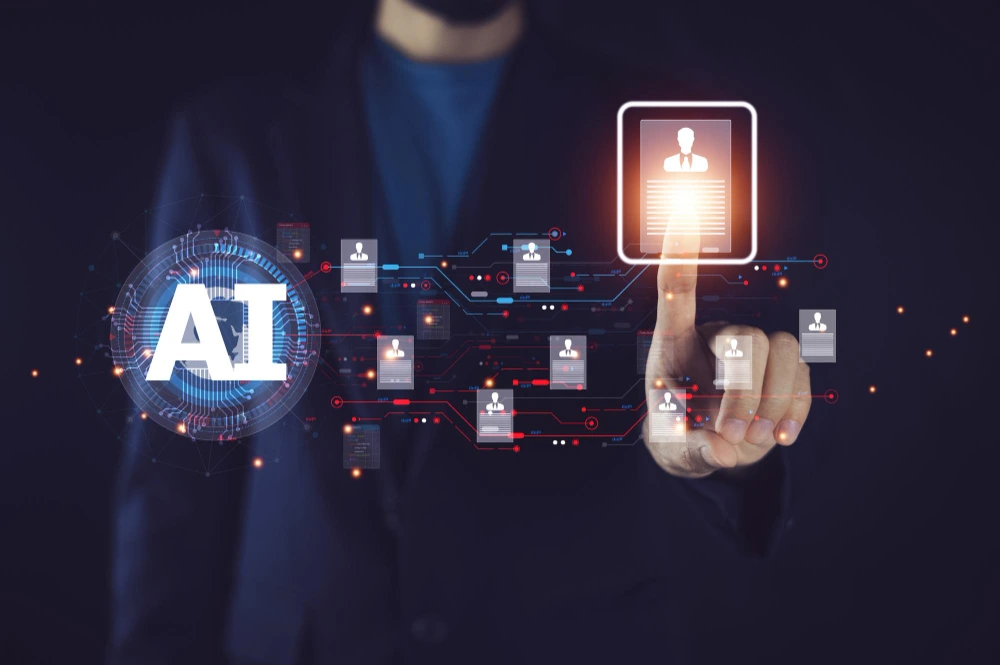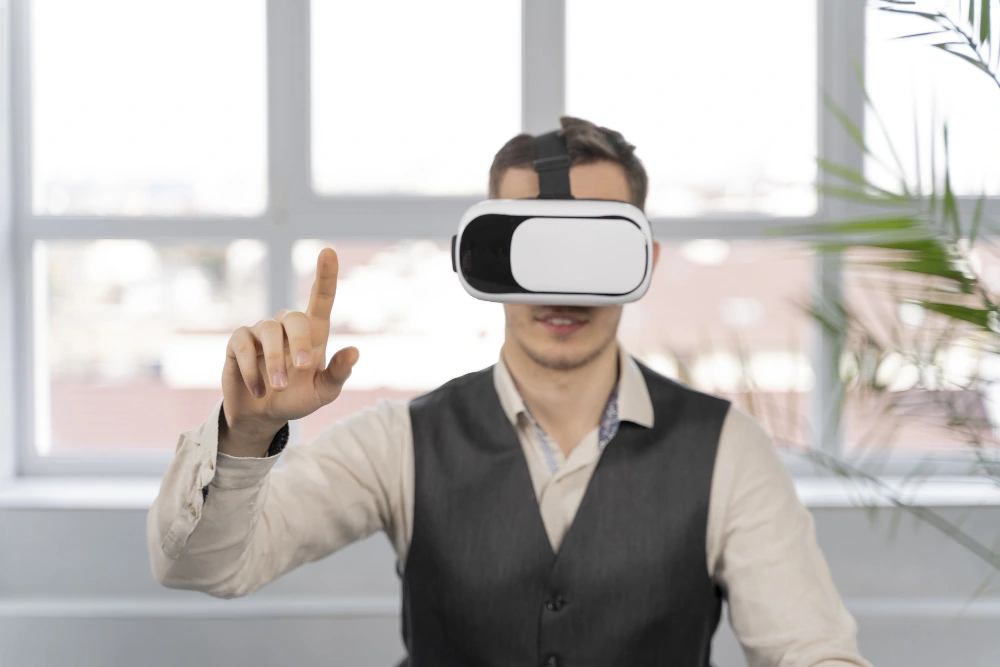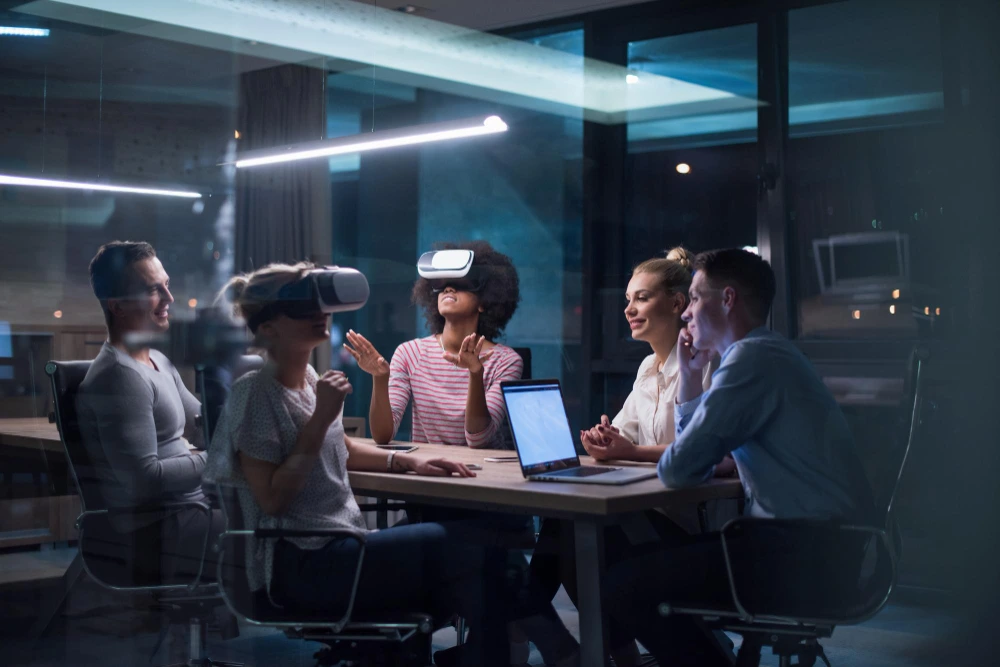The convergence of AI, AR, and VR is paving the way for a transformative era in HR, reshaping how we approach recruitment, training, and employee engagement.
While Artificial Intelligence (AI) has been progressively integrated into various industries, its capabilities in data analytics and decision-making processes make it particularly revolutionary for Human Resources.
AR is enhancing training and development programmes by offering immersive, interactive experiences that engage employees and foster deeper understanding.
Meanwhile, VR is making significant strides in recruitment and onboarding, allowing potential hires to experience the company culture and work environment virtually.
This technological trifecta is not just a glimpse into the future; it’s a reality that modern HR practices must adapt to.
Organisations that embrace these innovations are set to gain a competitive edge by creating more efficient and engaging workplaces, ensuring they remain at the forefront of their industries.
AI-powered recruitment

AI’s ability to handle vast amounts of data with speed and precision makes it an invaluable tool for HR professionals seeking to enhance productivity and decision-making.
When it comes to recruitment, AI can drastically reduce the time and effort typically required in traditional hiring processes. With AI-driven recruitment systems, HR teams can:
- Analyse resumes more efficiently, identifying the best-fit candidates based on predefined criteria.
- Utilise predictive analytics to determine the potential for candidates to excel in specific roles.
- Streamline the scheduling of interviews, interacting with candidates via automated chatbots.
By integrating AI into recruitment, organisations enjoy not just a more efficient hiring process but also improve the candidate experience. Job seekers benefit from quicker responses and more personalised interactions, thanks to AI’s ability to simulate human-like communication.
This synergy creates a seamless recruitment process that benefits both companies and job applicants.
Enhanced employee engagement with AI
The role of AI extends beyond hiring into enhancing employee engagement. Through sentiment analysis, AI can assess employee feedback, helping HR departments better understand staff concerns and morale levels. By leveraging this data, firms can implement targeted strategies to improve workplace satisfaction.
Here are some ways AI elevates employee engagement:
- Offering personalised professional development programmes based on individual performance data.
- Providing real-time feedback, allowing employees to adjust and improve continuously.
- Predicting and suggesting interventions for potential employee burnout.
This data-driven approach ensures that employee engagement strategies are not just reactive but proactive, addressing issues before they escalate. AI empowers businesses to foster a more connected and fulfilled workforce, which in turn enhances productivity and reduces turnover rates.
AI-driven HR solutions and their benefits
Several AI-driven HR solutions have emerged, each designed to address distinct HR challenges. Benefits of these solutions include:
- Increased accuracy in predicting employee performance and absenteeism rates.
- Flexibility in crafting customised analytics solutions to meet unique business challenges.
- Improved efficiency in managing HR tasks, reducing administrative burdens.
The capability to transform workforce data into actionable insights provides organisations with the means to make smarter spending decisions and enhance overall operational efficacy.
As the HR ecosystem continues to evolve, embracing AI technologies will remain a vital strategy for businesses eager to stay ahead in an increasingly competitive market.
Augmented Reality for training

As organisations strive to keep up with the rapid advancements in technology, Augmented Reality (AR) emerges as a dynamic tool that enhances educational and training methods.
AR provides learners with an interactive and immersive environment that fosters deep-rooted understanding and gathers tangible results.
In the realm of training and development, AR applications are being leveraged to create engaging training modules that go beyond traditional learning. Here are a few examples of AR’s transformative role in this space:
- On-the-job skill development: AR overlays digital information onto the physical world, allowing employees to practice tasks in a virtual environment while interacting with real-world elements. This visual and practical approach aids in cementing the skills learned.
- Remote learning: AR bridges geographical gaps, enabling remote teams to partake in virtual training sessions that replicate in-person learning experiences. Teams situated globally can unite in a single virtual space to share knowledge and learn collaboratively.
- Simulated scenarios: Industries such as aviation and healthcare use AR for training purposes by creating realistic simulations of challenging situations. This hands-on training helps employees prepare for critical situations in a controlled yet realistic environment.
Beyond specific instances, the benefits of incorporating AR into employee training and development are extensive:
- AR helps in reducing cognitive load by providing context-sensitive information, leading to quicker comprehension.
- It enables real-time performance tracking with feedback mechanisms that guide employees during their learning process.
- AR fosters a culturally rich learning environment, accommodating diverse learning preferences and enhancing the overall efficacy of training programmes.
Given these benefits, it’s no wonder that organisations are actively exploring AR-driven HR analytics for better decision making.
Employing tools equipped with AR capabilities can enhance training outcomes, increase productivity, and build a skilled workforce ready to tackle evolving industry challenges.
VR in candidate experience

Virtual Reality (VR) is reshaping the recruitment and onboarding landscape, offering a revolutionary way to create immersive candidate experiences.
By simulating real-life scenarios, VR allows potential hires to engage with their prospective work environments, gaining a comprehensive understanding of what it would be like to work in a specific organisation before committing.
One of the most significant advantages of VR in recruitment is its ability to present a realistic preview of the workplace culture and job responsibilities through virtual tours and simulations.
For instance, a sales candidate might experience a day at the office, enabling them to better assess their fit within the team. This immersive tool not only enhances the recruitment process by attracting tech-savvy talent but also minimises drop-offs post-hire.
The adoption of VR creates a dynamic recruitment process by presenting well-crafted and immersive experiences that bridge the gap between HR departments and potential employees.
Advantages of VR for onboarding processes
The impact of VR extends beyond recruitment into the onboarding process, where it plays a crucial role in enhancing new employee integration.
Traditional onboarding methods can be overwhelming, often inundating new hires with a plethora of information within a short span. VR addresses these challenges by:
- Providing interactive and engaging orientation programmes that captivate new employees’ attention with VR orientations involving gamified modules, making learning sessions enjoyable.
- Simulating complex workflows so the new hires can navigate their roles effortlessly before interacting with real-world tasks, thereby boosting confidence.
- Reducing training time by offering customisable modules where employees can learn at their own pace while tracking their progress.
By making onboarding more captivating and personalised, companies can reduce turnover rates and enhance employee satisfaction from the get-go.
Future potential of VR in HR practices
As VR technology continues to evolve, its potential applications in HR practices are bound to expand. Future trends may include:
- Tailored VR training programmes that adapt to individual learning curves and skillsets, fostering a more competent and adaptive workforce.
- Incorporation of AI within VR platforms to provide real-time feedback and performance evaluations during training sessions.
- Expansion of VR applications beyond onboarding to include team-building exercises and performance reviews, encouraging collaboration and feedback within a virtual space.
As these technologies evolve, organisations utilising solutions like those offered by MiHCM, such as MiA and MiHCM Data & AI, can expect an enhanced HR function, leading to a seamless recruitment process and streamlined HR operations.
Challenges in implementation
While the introduction of AI, AR, and VR into HR practices holds immense promise, the path to implementation is fraught with challenges.
Organisations may face resistance from employees unfamiliar with these new technologies, who may worry about job displacement or the steep learning curves associated with digital transformations.
Furthermore, the initial investment in infrastructure and technology can be significant, presenting a financial barrier particularly for smaller businesses.
- Sự phức tạp của tích hợp: Aligning these technologies with existing HR systems requires meticulous planning to ensure seamless integration without disrupting ongoing operations.
- Data privacy concerns: With AI and analytics comes the need to handle employee data securely and ethically, safeguarding against breaches and ensuring compliance with privacy regulations.
- Technical expertise requirements: The successful deployment of AR and VR calls for skilled professionals who can manage and maintain these systems, which can be challenging to acquire or develop internally.
Strategies to overcome technological challenges
To harness the full potential of AI, AR, and VR technologies, companies must adopt informed strategies to mitigate these barriers.
A phased approach to implementation can help in measuring the impact and making necessary adjustments along the way. Collaboration between HR and IT departments is crucial to address technical hurdles and optimise technology use.
- Employee training and engagement: Conduct comprehensive training programmes that demystify these technologies, focusing on their benefits and how they enhance rather than replace existing roles.
- Pilot programmes: Start with pilot programmes for smaller teams to gather feedback, improve interfaces and functionalities, and demonstrate ROI before a full-scale rollout.
- Vendor partnerships: Partner with technology providers who offer reliable support and regular updates to stay ahead with the latest advancements and maintain system integrity.
Insights into successful technology integration
Successful implementation hinges on aligning technology adoption with organisational goals.
Companies leveraging comprehensive solutions like MiHCM products can seamlessly integrate these advanced technologies into HR processes. Capabilities such as HR analytics facilitate data-driven decision-making and enhance recruitment processes, thus creating more efficient and productive workplaces.
To stay ahead in today’s competitive landscape, businesses must not only focus on leveraging the power of AI, AR, and VR technologies but also on crafting an environment conducive to innovation and continuous learning.
By understanding and strategically overcoming implementation challenges, organisations can unlock the full potential of these transformative tools, leading to improved recruitment efficiency, enhanced employee engagement, and a future-ready HR department.
Predicted trends

As technology continues to advance, the convergence of AI, AR, and VR will increasingly redefine HR methodologies, setting the stage for a more efficient and innovative workplace.
Looking ahead, the seamless recruitment process promises to become even more streamlined as these technologies mature.
AI will further integrate predictive analytics, refining HR decision-making and enabling organisations to anticipate workforce needs more accurately. The ability to visualise and simulate workforce performance will become vital in making smarter staffing and spending decisions.
- Smart workspaces: The emergence of smart, tech-enabled environments will transform how employees interact in the workplace, promoting a culture of collaboration and innovation.
- Adaptive learning: AR and VR will lead to the creation of adaptive learning environments tailored to individual employee needs, facilitating continuous professional development and engagement.
- Advanced employee well-being programmes: Leveraging AR and VR technologies, organisations can cultivate immersive experiences focusing on mental health and wellness, further enhancing employee satisfaction.
Innovative applications ahead
The integration of AI into VR platforms could soon enable real-time feedback and assessments during onboarding and training sessions, allowing employers to provide more personalised and impactful experiences. This will not only improve employee satisfaction but will also deepen their connection to the company.
As these technological trends evolve, organisations adopting comprehensive solutions like those provided by MiHCM products will stay ahead, benefiting from analytics, remote workforce management, and performance analysis to boost recruitment efficiency and HR operations.
Frequently asked questions
What are the benefits of using AI, AR, and VR in HR?
The use of AI, AR, and VR in HR brings numerous benefits. AI enhances recruitment and HR analytics, making decision processes data-driven and efficient. AR transforms training by providing immersive, interactive learning experiences, while VR creates engaging recruitment and onboarding processes. Together, they support building a diverse workforce, predicting performance, and fostering a more engaging workplace culture.
How do these technologies improve recruitment and onboarding?
What are the challenges in implementing AI, AR, and VR in HR?
Implementing these technologies may present challenges such as the need for significant initial investment, resistance from employees due to unfamiliarity, and data privacy concerns. Additionally, integrating these technologies with existing HR systems requires careful planning and expertise.



